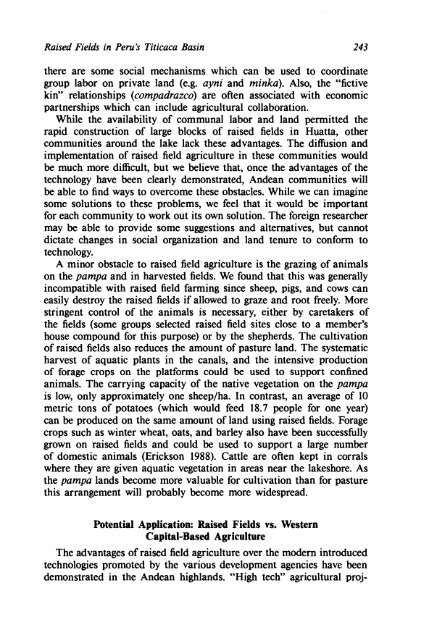Fragile Lands of Latin America Strategies for ... - PART - USAID
Fragile Lands of Latin America Strategies for ... - PART - USAID
Fragile Lands of Latin America Strategies for ... - PART - USAID
You also want an ePaper? Increase the reach of your titles
YUMPU automatically turns print PDFs into web optimized ePapers that Google loves.
Raised Fiela3 in Peru's Titicaca Basin 243<br />
there are some social mechanisms which can be used to coordinate<br />
group labor on private land (e.g. ayni and minka). Also, the "fictive<br />
kin" relationships (compadrazco) are <strong>of</strong>ten associated with economic<br />
partnerships which can include agricultural collaboration.<br />
While the availability <strong>of</strong> communal labor and land permitted the<br />
rapid construction <strong>of</strong> large blocks <strong>of</strong> raised fields in Huatta, other<br />
communities around the lake lack these advantages. The diffusion and<br />
implementation <strong>of</strong> raised field agriculture in these communities would<br />
be much more difficult, but we believe that, once the advantages <strong>of</strong> the<br />
technology have been clearly demonstrated, Andean communities will<br />
be able to find ways to overcome these obstacles. While we can imagine<br />
some solutions to these problems, we feel that it would be important<br />
<strong>for</strong> each community to work out its own solution. The <strong>for</strong>eign researcher<br />
may be able to provide some suggestions and alternatives, but cannot<br />
dictate changes in social organization and land tenure to con<strong>for</strong>m to<br />
technology.<br />
A minor obstacle to raised field agriculture is the grazing <strong>of</strong> animals<br />
on the pampa and in harvested fields. We found that this was generally<br />
incompatible with raised field farming since sheep, pigs, and cows can<br />
easily destroy the raised fields if allowed to graze and root freely. More<br />
stringent control <strong>of</strong> the animals is necessary, either by caretakers <strong>of</strong><br />
the fields (some groups selected raised field sites close to a member's<br />
house compound <strong>for</strong> this purpose) or by the shepherds. The cultivation<br />
<strong>of</strong> raised fields also reduces the amount <strong>of</strong> pasture land. The systematic<br />
harvest <strong>of</strong> aquatic plants in the canals, and the intensive production<br />
<strong>of</strong> <strong>for</strong>age crops on the plat<strong>for</strong>ms could be used to support confined<br />
animals. The carrying capacity <strong>of</strong> the native vegetation on the pampa<br />
is low, only approximately one sheep/ha. In contrast, an average <strong>of</strong> 10<br />
metric tons <strong>of</strong> potatoes (which would feed 18.7 people <strong>for</strong> one year)<br />
can be produced on the same amount <strong>of</strong> land using raised fields. Forage<br />
crops such as winter wheat, oats, and barley also have been successfblly<br />
grown on raised fields and could be used to support a large number<br />
<strong>of</strong> domestic animals (Erickson 1988). Cattle are <strong>of</strong>ten kept in corrals<br />
where they are given aquatic vegetation in areas near the lakeshore. As<br />
the pampa lands become more valuable <strong>for</strong> cultivation than <strong>for</strong> pasture<br />
this arrangement will probably become more widespread.<br />
Potential Application: Raised Fields vs. Western<br />
Capital-Based Agriculture<br />
The advantages <strong>of</strong> raised field agriculture over the modem introduced<br />
technologies promoted by the various development agencies have been<br />
demonstrated in the Andean highlands. "High tech" agricultural proj-

















